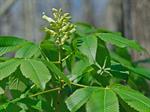| Family | Scientific Name | Common Name | Habitat | Distribution | Image |
|---|---|---|---|---|---|
| Sapindaceae | Aesculus flava | Yellow Buckeye, Sweet Buckeye | Moist forests, up to nearly 2000 m, especially prominent in seepy cove forests, in the Piedmont only in ‘montane’ habitats. | A broad Southern Appalachian endemic: sw. PA, s. OH, s. IN, and s. IL south through KY, WV, sw. VA, and TN to n. AL, n. GA, nw. SC, and w. NC. |  |
| Sapindaceae | Aesculus glabra var. arguta | Texas Buckeye, White Buckeye, Western Buckeye, Shrubby Buckeye | Limestone slopes, sandy open woodlands. | Se. IA and NE south to e. and c. TX. |  |
| Sapindaceae | Aesculus glabra var. glabra | Ohio Buckeye, Chalky Buckeye, Stinking Buckeye | Mesic upland and riparian forests, bluffs, ravines, stream banks; usually over calcareous substrates. | Largely midwestern, but ranges east to sw. PA, e. TN, and nw. GA (Jones & Coile 1988); it is also sometimes introduced eastward of its native distribution. It occurs in TN counties adjacent to VA. Reported as likely planted and weakly naturalizing in Shenandoah County, VA (Domangue & McMullen 2013). |  |
| Sapindaceae | Aesculus hippocastanum | Horsechestnut | Urban and suburban areas, perhaps not definitely naturalized, but fairly often planted as a street tree and escaping as seedlings in the vicinity of plantings. | Native of se. Europe. |  |
| Sapindaceae | Aesculus parviflora | Bottlebrush Buckeye | Mesic forests on bluffs and in ravines (the SC occurrence is on Fall Line river bluffs, with shaley, subcalcareous soils). | Wc. GA west to nc. AL, south to sw. GA and sw. AL; disjunct in wc. SC (Aiken County). See Wyatt (1985) for a discussion of the interesting, relictual occurrence in SC. Sometimes planted outside its native range, where it may persist and spread clonally. |  |
| Sapindaceae | Aesculus pavia var. flavescens | Edwards Plateau Buckeye | Calcareous woodlands, ravines. | Nearly endemic to the Edwards Plateau, TX, and sparingly in adjacent areas. |  |
| Sapindaceae | Aesculus pavia var. pavia | Red Buckeye | Coastal Plain marl forests (wet, calcareous flats), hardwood bluffs, rich floodplains of brownwater and blackwater rivers, basic-mesic forests, shell hammocks and shell middens, calcium-rich sandy soils in maritime forests. | Var. pavia ranges from se. NC south to c. peninsular FL and west to e. TX, extending north in the Mississippi Embayment to se. MO and s. IL, and in scattered occurrences off the Coastal Plain, as in sc. TN; also it is sometimes cultivated inland and persistent or slightly naturalizing. Fernald (1950) reports A. pavia from VA and WV, but there is likely taxonomic or nomenclatural confusion. |  |
| Sapindaceae | Aesculus sylvatica | Painted Buckeye | In the Piedmont in mesic, nutrient-rich forests, on bottomlands, lower slopes, and in ravines, in the Coastal Plain primarily on floodplains of brownwater (alluvium-carrying) rivers (most notably the Roanoke River in NC), in the Mountains only at low elevations. | Primarily a Southeastern Piedmont endemic, occurring primarily in the Piedmont from sc. VA south through c. NC, c. SC, and nc. GA to nc. AL, with an extension north into e. TN. |  |
Cite as...